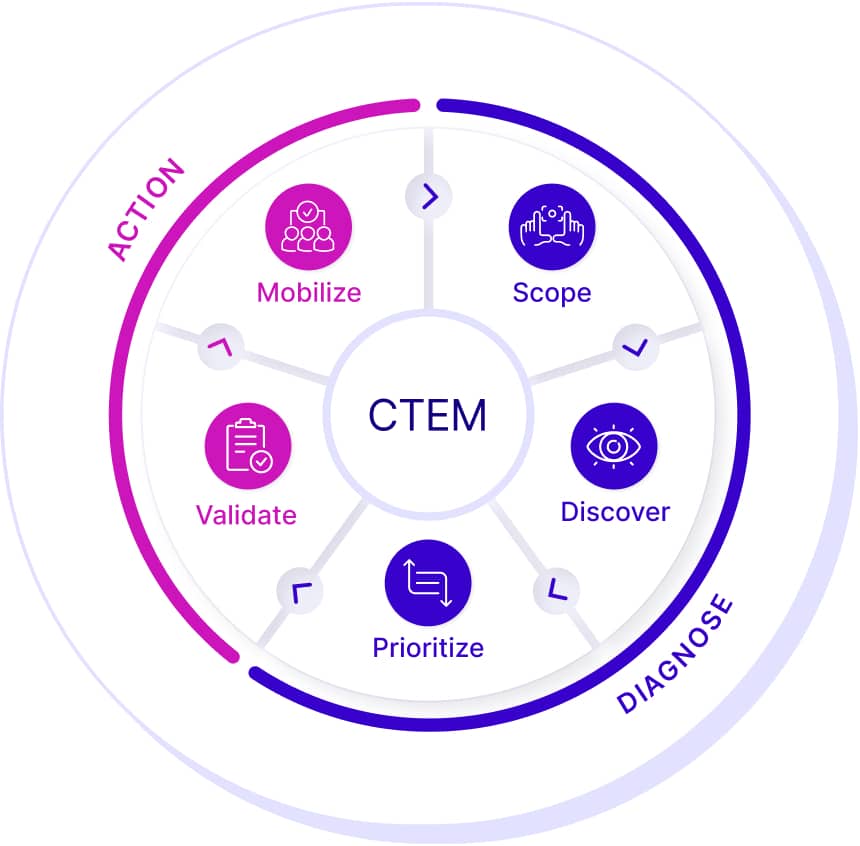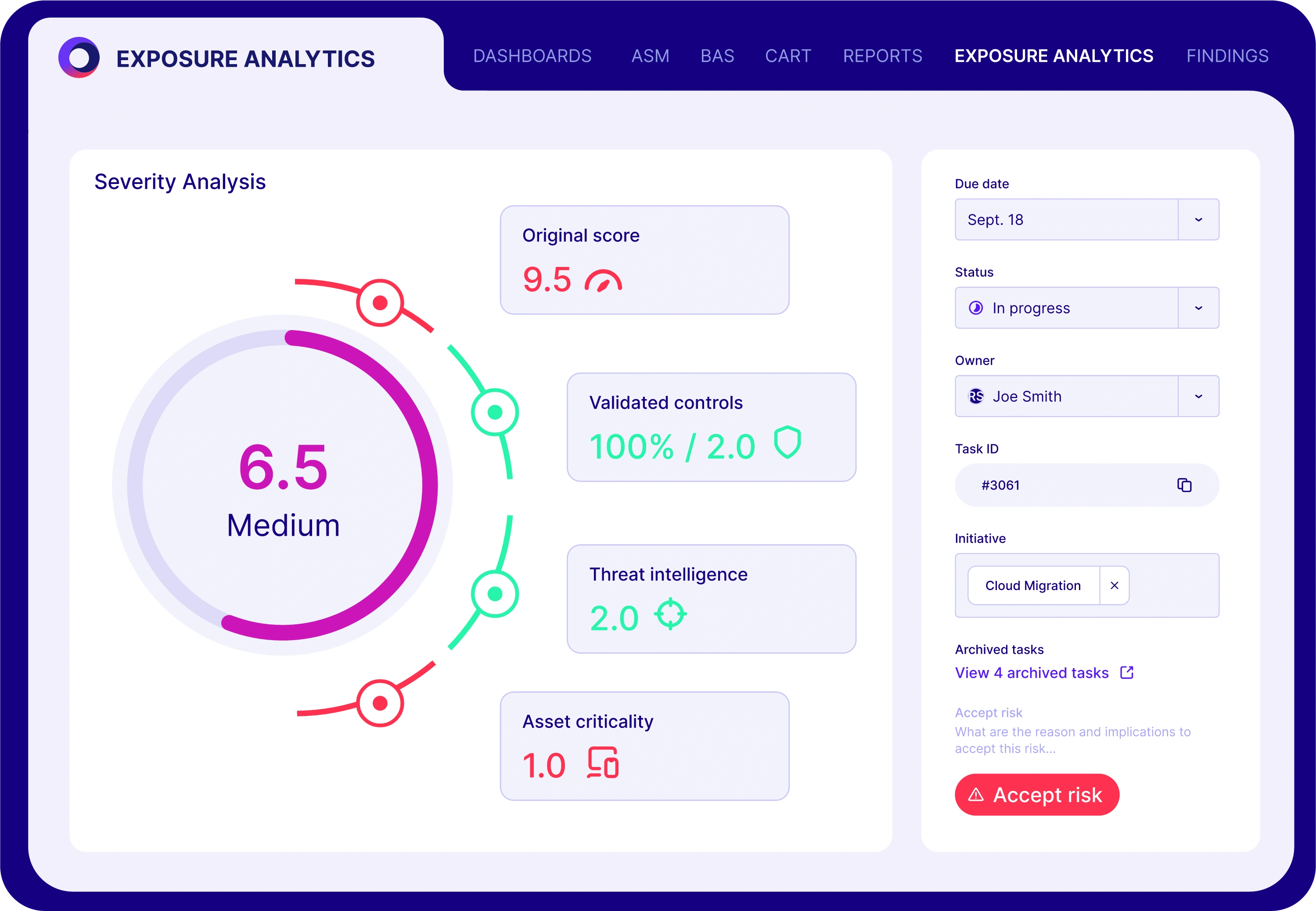Understanding the Ins and Outs of Cybersecurity Exposure Management

Exposure management takes a proactive approach to identify, validate, prioritize and mitigate the vulnerabilities, configurations, control gaps and other weaknesses that create exposure risk. It aims to answer the critical question “how exposed are we to cyber threats and potential breaches?” By integrating different parts of the cybersecurity program, exposure management strengthens cyber resilience, focusing on the risks with the greatest potential impact on the organization.
What is Exposure Management?
Simply put, exposure management is the process of identifying, assessing, prioritizing, and remediating potential vulnerabilities and security gaps in correlation with their business criticality and value.
When done successfully, exposure management helps security teams to:
- Understand weaknesses and gaps
- Test and validate the security controls, defenses and incident response
- Know the configurations across networks, systems, clouds, applications, data, SaaS and controls that make the organization vulnerable to attacks
Difference between exposure management and vulnerability management
While some may see exposure management as a logical evolution of vulnerability management, Gartner’s concept of CTEM draws a clear distinction. Exposure management must be both forward-looking to potential threats and aligned with organizational needs for defending against business disruption.
Exposure management extends far beyond traditional vulnerability management by incorporating scoping, validation, and mobilization. To achieve these steps, security organizations must move away from traditional scan-and-patch processes toward a more integrated program. This program should align with business priorities, include offensive testing for validation, prioritize actions based on risk, and recognize that mitigation is not just a quick tactical fix but a strategic optimization of the overall security posture.
How Does Exposure Management Work?
An ideal exposure management program typically follows a five-stage process, defined by Gartner as continuous threat exposure management (CTEM):

1. Scoping
Scoping lays the groundwork for effective exposure management programs by aligning the cybersecurity strategy with business risks, setting a clear focus, and defining measurable goals and objectives. According to Gartner, continuous threat exposure management should operate in concurrent cycles of focus, enabling iterative improvements.
In each cycle, scoping helps the organization determine what will be reviewed, narrowing the scope to reduce variables. It also establishes the business context and sets the criteria for success. This stage includes:
- Identify Business Operation Risks: While the scope of exposure management may be technical (cloud, data, SaaS, etc.) or focused on a critical organization function, the scope must always consider potential impact to business operations.
- Baseline Security Posture: To deliver measurable results, exposure management must start with an understanding of where you are today. The baseline considers the full attack surface in scope (such as assets, clouds, systems, etc.) and correlates it with business risks.
- Define Risk Tolerance: Exposure management programs recognize that many vulnerabilities cannot be patched, and remediation often involves business disruption. Aligning with the business on risk tolerance establishes the criteria and foundation for mitigation actions and determines the acceptability of disruption or risk.
2. Discovery
While scoping defines the business process itself, discovery identifies the systems, applications, and other resources that support that scope — even when those resources may not initially appear to fall within the scope. This constitutes the attack surface. The discovery phase creates a risk-profiled asset inventory of both the internal and external attack surface by identifying assets, classifying their business context, and assessing their potential cyber risks. This stage includes:
- External Discovery: Exposure management applies the attacker’s view to understand how the organization appears to the threat actor. This requires a comprehensive scan and discovery of the external attack surface, including web domains, IP addresses, web applications, databases supporting web applications, and asset libraries or other code components visible to the outside world.
- Dark Web Discovery: Discovery also includes monitoring the dark web to find stolen data, confidential business information, sensitive personal details, or counterfeit products.
- Internal Discovery: The goal of internal discovery is to uncover vulnerabilities and exploitable assets that contribute to exposure risk. This involves scanning the internal attack surface to identify assets an adversary could use to move from an initial foothold to critical assets or "crown jewels."
- Identify Vulnerabilities and Misconfigurations: Discovery should also focus on identifying vulnerabilities and misconfigurations across both external and internal systems that could expose the organization to attacks.
- Identify Control Weaknesses: Control weaknesses and gaps can be just as harmful as an unpatched CVE. Security programs that already incorporate control testing and validation should include these findings during the discovery phase of exposure management.
- Map Attack Paths: Attack path analyses map potential lateral movement paths across external and internal environments, highlighting risks from the chained exploitation of individual vulnerabilities.
- Consolidate Exposures and Create a Risk-Profiled Asset Inventory: Discovery should aggregate and analyze all findings into a unified view of exposure risk. Using this consolidated view of assets and exposures, organizations can create risk-profiled asset inventories that factor in the business context of each asset.
3. Prioritization
Prioritization in exposure management focuses on addressing the most likely threats. Unlike traditional vulnerability management, which relies on external factors like CVSS scores and threat intelligence, it also takes into account internal factors such as compensating controls, business context, and available mitigation options. This stage includes:
- Stack Rank Exposures: Effective prioritization involves ranking all exposures based on key factors such as risk, potential impact on business operations, and threat intelligence related to active campaigns and targeted industries. While prioritization has traditionally been a challenge for vulnerability management, applying risk-based vulnerability management principles to all exposures becomes feasible when organizations start with a consolidated list and a risk-profiled asset inventory.
4. Validation
Validation is one of the key advantages of exposure management over traditional programs like vulnerability management. It confirms exposure risk by evaluating the likelihood of an attack's success and its potential impact. While some argue that prioritization isn’t effective without validation, Gartner analyst Pete Shoard differentiates the two: prioritization acts as the “sort” function, while validation serves as the “filter.”
This validated risk filter enables security teams to focus remediation efforts on the exposures that pose the greatest risk. Legacy validation methods, such as periodic penetration tests and red team exercises, are limited. Exposure management emphasizes the need for continuous assessment, requiring automated technologies that provide broad coverage across the attack surface.
- Validate Controls and Response: Validating controls and optimizing responses are key ways exposure management improves security posture over time. For exposure risks, validation tests whether existing controls can mitigate attacks targeting those vulnerabilities. If a threat cannot be mitigated, assessments evaluate response processes and the ability to contain the threat. Exposures mitigated through compensating controls carry significantly lower risk.
- Validate Threats : The disclosure of new high-severity vulnerabilities or the report of new exploits or active campaigns from threat actors often requires urgent testing to validate the risk to the organization.
- Validate Attack Paths: Attack path validation demonstrates how exposures and vulnerabilities can be exploited and the potential consequences of a compromised asset, such as lateral movement and privilege escalation. By validating these paths, security teams can confirm the viability of attacks and understand the overall potential damage a successful attack could cause.
5. Mobilization:
The mobilization phase is the action-driven step of an exposure management program. It involves taking concrete actions to reduce organizational risk and strengthen security posture based on insights gathered during the process. Once fixes are implemented, their effectiveness should be validated to ensure they achieve the intended reduction in exposure and to identify any remaining security gaps.
- Plan Remediation: Effective response is often not straightforward, especially for complex remediations that require collaboration and alignment across teams. A successful remediation plan should take into account the business impact of an exploited threat, the tradeoffs between remediation and mitigation along with available options, the potential disruptions caused by remediation efforts, and the technical requirements of the proposed actions.
- Automate Configuration Updates: Whenever possible, automated remediation and mitigation through configuration and control updates offer a quick and efficient response. This approach frees up valuable human resources to concentrate on more complex remediation processes.
- Managing the Remediation Process: The final step involves creating and assigning specific remediation tasks to designated owners, ensuring accountability to drive execution. Tracking task completion through metrics and dashboards is essential for monitoring progress and confirming that risk reduction goals are achieved.
Key Exposure Management Solutions and Their Role in the CTEM Approach
Exposure management differs from traditional vulnerability management by incorporating the attacker’s perspective of an organization’s assets—something traditionally provided by penetration tests. Now, advanced tools can automate this offensive security mindset, delivering automation, analytics, and actionable insights to help organizations effectively manage exposure.
Breach and Attack Simulation (BAS):
BAS tools answer the question: “How well are my security controls and processes performing?” They launch attack simulations and correlate the findings to security controls (email and web gateways, WAF, endpoint, or others) to provide mitigation guidance. BAS solutions are instrumental during the prioritization and validation stages.
Continuous Automated Red Teaming (CART):
CART tools go beyond the ASM reconnaissance phase to answer the question: "How can an adversary breach my defenses and internal segmentation?" CART tools simulate an end-to-end campaign attempting to penetrate the organization by analyzing exposed vulnerabilities and autonomously deploying attack techniques that penetrate the network. CART solutions are instrumental during the prioritization and validation stages.
Exposure Analytics
Exposure analytics tools automate the data collection, aggregation, and exposure intelligence across enterprise IT, clouds, and the security stack. It pulls data from vulnerability management platforms, asset inventories, clouds, security controls, and the IT infrastructure. Data are aggregated to contextualize the information with business relevance, prioritize remediation, and measure and optimize cyber resilience. Exposure analytics solutions are instrumental during the scoping, discovery, prioritization, and mobilization stages.
The Benefits of Exposure Management
Implementing an exposure management program within an organization offers numerous benefits:
- Reduced Risk of Data Breaches: By proactively identifying and addressing vulnerabilities, organizations can significantly reduce the risk of successful cyberattacks, safeguarding sensitive data and protecting their reputation. Exposure management allows organizations to stay ahead of emerging threats and continuously improve their security posture.
- Improved Compliance with Security Regulations: Exposure management helps organizations ensure compliance with industry-specific security regulations and standards. This avoids legal consequences and builds trust with customers and stakeholders. Compliance with security regulations is critical for organizations operating in highly regulated industries, such as finance, healthcare, or government sectors.
- Improved Cyber Insurance Conditions: The ability to document efforts to reduce exposure and proactively remediate security gaps is instrumental in facilitating negotiations with cyber insurance underwriters, potentially resulting in lower premiums and expanded coverage.
- Increased Efficiency in Security Operations: Focusing on the most critical security gaps, exposure management enables organizations to allocate resources effectively, streamline security operations, and optimize their overall cybersecurity strategy.
- Improved Decision-Making about Security Investments: Insights into organizations’ security posture helps them make informed decisions regarding security investments, ensuring resources are allocated where they are most needed.
- Increased Involvement of All Stakeholders: Cymulate 2022 Data Breach Survey indicated that regular meetings involving both executives and cybersecurity teams reduce the risk of breach. Integrating exposure analytics directly ties cybersecurity with the non-IT executive-level stakeholders and increases their involvement in shoring up security.
Cymulate Exposure Management Platform

Cymulate understands the importance of integrating siloed SecOps functions with supporting technologies to drive exposure management from scoping to mobilization. To assist security teams on their journey, the Cymulate Exposure Management Platform unites essential technologies, including:
- Breach and attack simulation
- Automated red teaming
- Exposure analytics
- Security control validation
The Future of Cybersecurity is Exposure Management
Exposure management is transforming how organizations address cyber risks, shifting from reactive measures to proactive strategies. By reducing exposure, prioritizing risks, and building resilience, it equips businesses to face evolving threats with confidence. As the cybersecurity landscape continues to change, exposure management is key to staying one step ahead.


